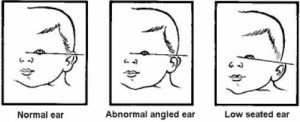a. Eyes.
The infant’s eyes may be folded and creased and may seem out of shape because they contain little hardened cartilage. The infant’s eyes may not track properly and may cross (strabismus) or twitch (nystagmus). This will cause concern if it extends beyond six months.
(1) Color. At birth, the iris color is usually grayish-blue in Caucasians and grayish brown or brown in dark-complexioned races. A gradual deposition of pigment produces the final eye color of the baby at the age of three to six months and sometimes it may take a year.
(2) Pupils. The pupils do react to light and the infant can focus on objects about eight inches away. The infant’s blinking is a natural protection reflex.
(3) Lacrimal apparatus. The lacrimal apparatus is small and nonfunctioning at birth and tears are not usually produced with crying until one to three months of age.
b. Ears.
The infant’s ears tend to be folded and creased. A line drawn through the inner and outer canthi of the eye should come to the top notch of the ear where it joins the scalp (see figure 7-5). The infant usually responds to sound at birth.

